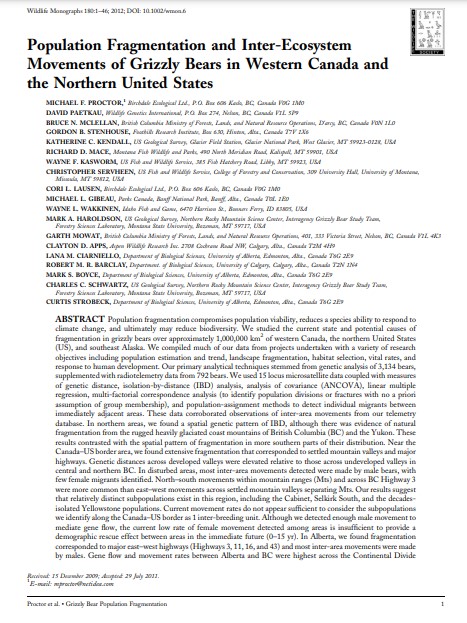Population fragmentation and inter-ecosystem movements of grizzly bears in Western Canada and the Northern United States
Bosque Modelo:
Foothills
Temática:
Conservación
Tipo de documento:
Artículo científico
Resumen
Population fragmentation compromises population viability, reduces a species ability to respond to climate change, and ultimately may reduce biodiversity. We studied the current state and potential causes of fragmentation in grizzly bears over approximately 1,000,000 km2 of western Canada, the northern United States (US), and southeast Alaska. We compiled much of our data from projects undertaken with a variety of research objectives including population estimation and trend, landscape fragmentation, habitat selection, vital rates, and response to human development. Our primary analytical techniques stemmed from genetic analysis of 3,134 bears, supplemented with radiotelemetry data from 792 bears. We used 15 locus microsatellite data coupled with measures of genetic distance, isolation-by-distance (IBD) analysis, analysis of covariance (ANCOVA), linear multiple regression, multi-factorial correspondence analysis (to identify population divisions or fractures with no a priori assumption of group membership), and population-assignment methods to detect individual migrants between immediately adjacent areas. These data corroborated observations of inter-area movements from our telemetry database. In northern areas, we found a spatial genetic pattern of IBD, although there was evidence of natural fragmentation from the rugged heavily glaciated coast mountains of British Columbia (BC) and the Yukon. These results contrasted with the spatial pattern of fragmentation in more southern parts of their distribution. Near the Canada–US border area, we found extensive fragmentation that corresponded to settled mountain valleys and major highways. Genetic distances across developed valleys were elevated relative to those across undeveloped valleys in central and northern BC. In disturbed areas, most inter-area movements detected were made by male bears, with few female migrants identified. North–south movements within mountain ranges (Mts) and across BC Highway 3 were more common than east–west movements across settled mountain valleys separating Mts. Our results suggest that relatively distinct subpopulations exist in this region, including the Cabinet, Selkirk South, and the decadesisolated Yellowstone population
Información Bibliográfica
Autor:
Proctor, M.F., Paetkau, D., McLellan, B.N., Stenhouse, G.B., Kendall, K.C., MacE, R.D., Kasworm, W.F., (...), Strobeck, C.
Revista:
Wildlife Monographs
Año:
2012
N°:
-
País :
Canadá
Páginas:
1 - 46
Volumen:
180
Idioma:
Ingles
Palabras claves
climate change, demographic fragmentation, DNA, gene flow, grizzly bear, microsatellites, population assignment, population fragmentation, radio telemetry, Ursus arctos.





